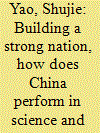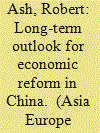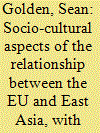|
|
|
Sort Order |
|
|
|
Items / Page
|
|
|
|
|
|
|
| Srl | Item |
| 1 |
ID:
071615


|
|
|
|
|
| Publication |
2006.
|
| Summary/Abstract |
During the immediate aftermath of the 1997 ASEAN crisis, instead of promoting a further "deepening" of the integration process, ASEAN has preferred enlarging its membership and has opened up to its Northeast Asian partners, Japan, China and South Korea. The mounting economic trade flows among those actors necessitates calls for the coherent creation of effective regional structures. China in particular, among the three mentioned countries, has come to the fore with its diplomatic strategies concerning the regional architecture. As results of these recent changes, the structure of power and the nature of the regional system are altering and ASEAN is going through a decisive transition. Taking into consideration the speed of the evolving framework with the enlargement of an East Asian Community, ASEAN would need a new political vision for the region, for the redefinition of its internal balance of power and for the elaboration of a clear approach toward external partners. Crucial problems affect the entire area such as deficit of democracy, wide development gaps among the East Asian countries, the widespread need for economic liberalisation and need for new human and regional security policies. The EU would play a fundamental role in addressing these problems and would be well inspired to avoid considering Southeast Asia as just a mere periphery of China.
|
|
|
|
|
|
|
|
|
|
|
|
|
|
|
|
| 2 |
ID:
071612


|
|
|
|
|
| Publication |
2006.
|
| Summary/Abstract |
A common perception is that China has relied on the expansion of labour-intensive industries and flooded the world market with cheap but low to medium level technology products. Although it has become the third largest exporting nation, China has failed to create a large number of big businesses that can compete with the world’s leading multinational companies (Nolan (2004)). The Chinese government has long been aware of the weakness of its development strategy and has been trying to improve its own technological capacity through investments in basic research, innovations and the application of new technologies, utility models and designs. China’s strategy on science and technology can be best described by the so-called ‘walking with two legs’ principle. The first leg is based on building up domestic research and innovative capacity. This is through investments in research institutes, universities and LMEs. China’s second leg has been to build up its technology capacity through its open policy and attracting FDI and technology. China has made significant advances in the following areas regarding science and technology.
– Research and innovative activities have been encouraged and supported by the central and regional governments.
– More research and innovative activities are encouraged in the LMEs.
– HEIs have become increasingly important for research and innovative activities.
– The export-push strategy and encouragement of FDI inflow are two important venues for importing advanced foreign technologies.
China also has a number of weaknesses in science and technology.
– Research expenditure has not kept up with economic development.
– There are not enough big businesses that are highly innovative and cannot compete effectively with the world’s largest multinational enterprises.
– China is weak in the key industries that are intensive with advanced technologies, computer software, aircraft, automobile and electrical appliances, etc.
– Most of the LMEs are state-owned and are renounced for their inefficiency and loss-making.
– China has greatly depended on foreign technologies for its economic development.
– China’s expenditures on science and technology have been low by international standards and low compared to its fast economic growth.
– China’s economic growth has been heavily dependent on investments and labour and not so much on technological progress and efficiency improvement.
|
|
|
|
|
|
|
|
|
|
|
|
|
|
|
|
| 3 |
ID:
071608


|
|
|
|
|
| Publication |
2006.
|
| Summary/Abstract |
China's post-1978 economic reform is generally acclaimed as success, for the Chinese economy has expanded nine-fold in a matter of 25 years and the country rose from the world's 34th largest trading nation in 1978 to the third largest in 2004 ahead of Japan. Interestingly, the Chinese experiment is often described in the West as "economic reform without political reform". This begets the question: how could a politically un-reformed system be able to deliver such an economic miracle? In reality, China has conducted, by its own standards, major political reforms since 1978. Though far short of the Western expectations, the Chinese experience since 1978 should better be described as "great economic reforms with lesser political reforms", without which China's economic success would be inconceivable. China's "lesser political reforms" have reduced country's opportunities for greater political change, thus alienating many reform-minded intellectuals. Nevertheless, it may also have helped China avert the possible economic and social upheavals which could have resulted from rushing too fast into a radically different economic and political system. There is a strongly held belief, especially among the more 'ideological' observers of Chinese affairs that unless there were a radical political reform, perhaps tantamount to a revolution, to rid China of its "oppressive" Communist Party, the Chinese system would inevitably collapse just like what had happened in the USSR and Eastern Europe. As the party has been in power, China had been predicted to face collapse in the aftermath of the Tiananmen crisis of 1989, the Soviet Union's disintegration of 1990, the death of Deng Xiaoping in 1996, and the Asian financial crisis of 1997 and the 2003 outbreak of SARS. Yet all these forecasts turned out to be wrong and the track record of the China doomsayers over the past 20 years is indeed poor. Will China become a democracy through its political reform in 20 years? Indeed, a full democracy could be the best scenario for China, the region and beyond, but it is difficult to give a definitive answer, which will, to a great extent, depend on how to achieve democracy in China, i.e. the costs/risks involved, as well as what kind of ultimate shape such a democracy will take. If full-fledged democratisation will take more time, the pressure for a more accountable government and more democratic society is growing, and this trend will continue with the rise of China's middle class and civil society. Therefore, the most likely scenario for China in the coming two decades is that China will continue its own approach to political reform, and the relative successful experience of China's economic reform may well set a pattern for China's political reform in the years to come. As part of Europe's general approach towards China's political change, it is in Europe's interest to assist, in line with the view of most Chinese, gradual reform rather than revolution or 'regime change', which could produce hugely negative consequences for China itself, Sino-European relations and European interests in China and even East Asia.
|
|
|
|
|
|
|
|
|
|
|
|
|
|
|
|
| 4 |
ID:
071609


|
|
|
|
|
| Publication |
2006.
|
| Summary/Abstract |
In China, the inequalities generated by the reforms in the last two decades have been increasing. As a result, the unequal regional and sectoral impact of development associated with the growth-maximisation strategy, has given rise to increasingly severe social and economic tensions and contradictions. The threats to political stability posed by these developments remain, for the time being, potential more than real. But the damage which they have caused to the social, economic and environmental fabric of China is already evident. The main critical facts are: 1) the rise in urban unemployment, both de facto and concealed, that has accompanied the halting restructuring programme among state-owned enterprises (SOEs); 2) the massive reservoir of underemployment that affects at least 130 million farmers; 3) the absence of even basic social security provision for the sick, the unemployed and the old; and the highly differentiated access to education; 4) the pervasiveness of corruption and its destructive impact on the normative framework that usually regulates human economic and social behaviour, to the detriment of the social contract between state and individual.
Economic and social polarisation associated with China’s growth-maximisation strategy has become the single most important domestic issue facing the Chinese government. Emphasis by the Hun Jintao-Wen Jiabao administration on a new “people-centred” development strategy highlights the urgency of this problem. When added to the pressures of resource shortages and environmental degradation, the case in favour of shifting from growth-maximisation to sustainability appears to be unanswerable. These are the concerns that have prompted government leaders and officials to question China’s existing development strategy and to formulate a “scientific” concept of sustainable and “harmonious” development.
The most authoritative explanation of the new strategy was articulated by Hu Jintao in a speech he made in May 2004, which was subsequently republished in the Party’s leading theoretical journal (Qiushi). In it, Hu demanded a radical change in China’s growth model from one characterised by “high input, high consumption, high pollution, and low efficiency” to a new approach, based on “high science and technology contents, good economic benefit, low resource consumption, less environmental pollution, and full exploitation of human resource advantages.” This change in emphasis was designed to help resolve “prominent contradictions”, such as the excessive pace and scale of fixed-asset investment, which threatened not only to exacerbate resource shortages, but also to generate inflationary pressures attendant on excessive expansion of credit
|
|
|
|
|
|
|
|
|
|
|
|
|
|
|
|
| 5 |
ID:
071607


|
|
|
|
|
| Publication |
2006.
|
| Summary/Abstract |
Six shaping factors will determine the short-to-medium term outlook for East Asia. Two of these are geo-political flashpoints, with implications beyond the region-North Korea and China-Taiwan cross-strait relations. For both of these at least some logic of a' solution' will need to be worked out. Intra-regional tensions between China, the fastest growing economy in the world, and Japan, the second largest economy in the world, will need accommodation and compromise. Fourthly, the relationship between the US and China remains ambivalent, veering between strategic partnership and strategic competition. Long term stability in the region will require that the US-China relationship becomes more predictable, which will only be possible if both players define their long-term interests innovatively and in different ways. Probably the most important shaping factor for the region is the domestic political economy of China. The nexus between Chinese economic growth and its domestic political stability needs to remain in tact-without economic growth no political stability, while stability is a precondition for continued growth. These five shaping factors together will determine the scope of multi-lateral problem-solving frameworks for the region. The Kuala Lumpur first East Asia Summit has shown the determination of leaders in the region to co-ordinate, share information and exchange views. However, the decision not to go beyond the current institutional set-up and to retain ASEAN's centrality points to a continuation of the present 'shallow' integration for some time to come.
|
|
|
|
|
|
|
|
|
|
|
|
|
|
|
|
| 6 |
ID:
071619


|
|
|
| 7 |
ID:
071617


|
|
|
|
|
| Publication |
2006.
|
| Summary/Abstract |
This paper presents a comparative study about words and about sovereignty; about the ancestry of the words that construct the discourse of sovereignty in the context of China; about the analysis and interpretation of the civic discourse and the rhetoric that construct Chinese sovereignty in the field of international relations and foreign policy, and about the consequences of this analysis and interpretation for the formulation of EU foreign policy with regard to East Asia, especially China, and the United States, as well as the feedback that notions of sovereignty have on the construction of Chinese civic discourse. For many contemporary Chinese thinkers, China should modernise without repeating the process of modernism, should leap over the system of values established by the Enlightenment that seemed to justify imperialism, and develop an economy and institutions that would serve to create wealth and to raise the standard of living of the population, without imposing values that are advantageous to a “West” that is already wealthy. They have identified a cultural dissidence within developed societies that advocates the values of postmodernism as a way of rejecting the values of modernism. In this context, they advocate the possibility of modernising their society without having to accept the imposition of values that originated in societies that have already begun to question them. In this way, China could reach postmodernism in a relatively short period of history without having to pass through the traumas that characterised the development of modernism in the “West” over a period of centuries (it would be difficult not to discern echoes of Mao Zedong’s “Great Leap Forward” in these Chinese versions of the postmodernist paradigm). The communicative strategy to be adopted by the EU in the rhetorical construction of its dialogue with China should be fully cognizant of and sensitive to the criteria of China’s moral order as outlined in this study and specified in the Five Principles (mutual respect for sovereignty and territorial integrity; non-aggression; non-interference in each other’s internal affairs; equality and mutual benefit; and peaceful coexistence), the Spirit of Shanghai and the ASEAN Way, with special emphasis on mutual recognition, parity of esteem, and mutual benefit. Any other discourse will be perceived semiotically as unilateralist and exploitative. Respect for diversity is paramount, and the ability to harmonise diversity is a major function of Chinese political and cultural thought. “Harmony” and “peace” are the same word in classical Chinese: hé ( hépíng is the modern word for “peace” and hésh?ng is the modern word for “harmony”). As a result, any practice that produced harmony, such as music or cooking, was a form of training for maintaining peace, social cohesion and solidarity in society (or among nations).
|
|
|
|
|
|
|
|
|
|
|
|
|
|
|
|
|
|
|
|
|